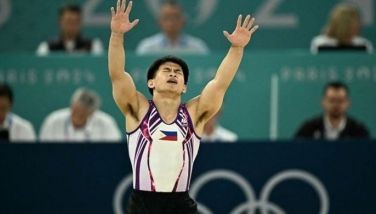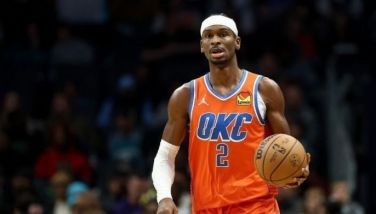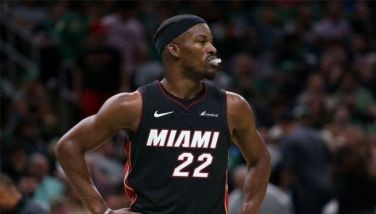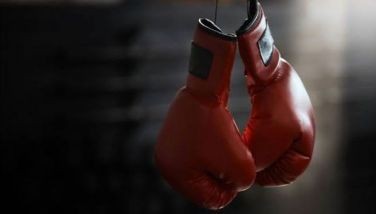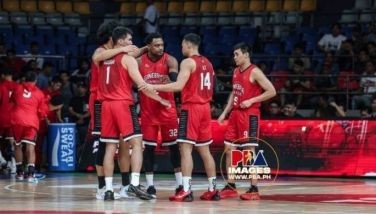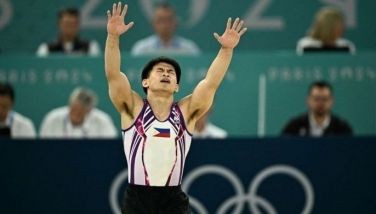Top sportscribe enthralled by RP

February 27, 2003 | 12:00am
In 1999, renowned Sports Illustrated writer Alexander Wolff visited Manila and was enthralled by the Filipino’s passion for basketball. He was in the course of writing a book on the impact of the game all over the world. Wolff knew the book couldn’t be complete without a chapter on the Philippines’ love affair with hoops.
The book entitled "Big Game, Small World–A Basketball Adventure" (424 pages, New York: Warner Books, available on amazon.com) was published last year to rave reviews. John Paul Newport, in the New York Times Book Review, described Wolff’s reporting as "terrific" and said the most entertaining chapters focus on people torn between their love of the game and conflicting, often incongruous, forces.
In the book, Wolff wrote about a former All-American Japanese women’s league import who became a cloistered Poor Clare nun, the basketball-playing King of the tiny Himalayan kingdom of Bhutan, the multi-ethnic Yugoslav team that won the 1987 World Junior Championships and later sent four alumni to the National Basketball Association (NBA), among others.
Wolff traveled the globe to bring out the most interesting cage lore ever compiled in a single must-have book. His chapters on Lithuania, Poland, Switzerland, Italy, Sarajevo, Bosnia, Ireland, Israel, China, Brazil, Japan, Bhutan, France, and Angola are gems of prose and insight. A master craftsman whose gift of putting words together in making a story come alive is rare, Wolff reserved some of his best prose for the chapter on the Philippines which he called, in a personal letter to this writer, "the land of creativity, action, and surprises."
In Wolff’s 16-page chapter on the Philippines, he recounted talks with former Philippine Basketball Association (PBA) commissioner Jun Bernardino, former national coach Ron Jacobs, Sen. Robert Jaworski, Alaska coach Tim Cone, RFM Corp. president Joey Concepcion, and Dennis Villanueva who runs a neighborhood 3-on-3 tournament in a small barangay near the Hyatt Regency Hotel in Pasay City to keep kids out of trouble.
While in Manila for only five days, Wolff showed a remarkable knack for picking up on local culture–another gift. In his book, he was as comfortable using terms like "talunan," "barangay," "barong tagalog," and "tsismis" as any term in basketball lingo. Wolff also put perspective into his piece by situating the Philippines in history–its colonization, its liberation, and its consequent "borrowed cultural identity." What struck Wolff was the country’s parody of things American, "in basketball and beyond."
In his book, Wolff marveled at how the American game has captured the imagination of millions who embrace it almost as a religion. So the Philippines is no exception.
Wolff, who came with wife Vanessa, made quite an impression in Manila. He was friendly, courteous, and so grateful of Filipino hospitality. Wolff met such personalities as Star president Miguel Belmonte, Nic Jorge, Ramon Fernandez, Yeng Guiao, Joseph Uichico, Alfrancis Chua, Perry Ronquillo, Norman Black, Rey Gamboa, Aric del Rosario, Col. Julian Malonso, Caloy Loyzaga, Tony Genato, Ramoncito Campos, Bobby Rius, and even one-armed La Salle girls point guard Kathryn Grace Tan.
Replying to a question from a Filipino in a basketball website, Wolff recently said: "The Philippines is surely a likely breeding ground for the next Asian power, particularly if that next player will be the NBA’s first new big man from that world. That’s because Filipinos have an extraordinary passion for and understanding of the American professional game and because the PBA, unique among world leagues around the world, ignores the FIBA (International Basketball Federation) rulebook and follows the NBA’s, bylaw for bylaw."
Wolff, 45, started as a fact-checker in Sports Illustrated over 20 years ago and rose to become a senior writer. He has authored six books so far–each of them brilliant, incisive, and insightful.
Wolff, his wife, and their baby boy Frank live in a Vermont farmhouse.
Continuing his association with the Philippines, Wolff wrote about a college football hero who survived the Bataan Death March in World War II in the Jan. 27, 2003, issue of Sports Illustrated.
The piece was on former Notre Dame fullback Mario (Motts) Tonelli who scored a dramatic last-minute touchdown to lift the Irish to a 13-6 win over Southern California in 1937. He enlisted in the military and joined an anti-aircraft unit that was stationed at Clark Air Base when Japan attacked Manila in 1941.
Tonelli was a part of a Fil-Am joint contingent that battled the Japanese for five months in Bataan before surrendering. He was among 78,000 captives who began the seven-day, 60-mile trek in Mariveles to San Fernando. One man died every dozen paces as Japanese soldiers bayoneted stragglers and shot those who couldn’t go on.
"For meals, the prisoners were lucky to receive a spoonful of lugaw, a gruel of rice," wrote Wolff. "But the cruelest treatment of all was to be ordered to stand, in the high hours of the Philippines’ hottest and driest month, alongside a bubbling artesian spring, knowing that to take a drink would ensure decapitation. At night, Tonelli would lay his uniform on the grass to catch the dew then wring out a few precious drops in the morning."
Tonelli’s Notre Dame class ring was taken by a Japanese soldier but later returned to him by a lieutenant who spoke perfect English and said he once studied at Southern California. The lieutenant remembered Tonelli’s role in Notre Dame’s win over his alma mater in 1937. It was an unexpected gesture since before the march, Japanese troops took West Point rings from US officers by slicing off their fingers and pulled gold fillings from the mouths of captives with pliers.
From San Fernando, the prisoners were placed in railroad coaches for the 25-mile trip to Capas where they disembarked to march eight more miles to Camp O’Donnell. The death rate at the camp was alarming-one of every six prisoners died and as many as 30 were buried in a day. From O’Donnell, Tonelli was moved to Cabanatuan where 2,500 prisoners died in six months.
Wolff said more than 30 former college football players were in the Death March and 12 survived, including Kearie Berry of Texas and halfback Elgin Radcliff of Penn State.
In 1942, Tonelli was among 1,000 prisoners brought from Cabanatuan to grow food in a Mindanao prison farm. Two years later, Tonelli and 1,000 other prisoners lived under subhuman conditions for 62 days at sea on board a captured merchant vessel, a "hellship," to be transported to Japan. They were made to do manual work in Japanese labor camps until the war ended. He was imprisoned for 1,236 days and weighed less than 100 pounds upon returning home.
In retrospect, it was as if football saved Tonelli’s life. His athletic body survived the rigors of imprisonment and the Japanese lieutenant–whose identity remains unknown–wouldn’t have been so gracious if he didn’t remember his 1937 gridiron heroics.
"If you accept, as Tonelli did, that the ring sustained him, then that run against Southern Cal had allowed him, through the grace of a man who knew of it, to continue to draw from some talismanic power," wrote Wolff. "In a sense, Tonelli had, on a long ago November afternoon (in 1937), run for his life."
Wolff paid Tonelli a visit before Christmas last year in Skokie, a Chicago suburb, and conjured visions of an exciting tale. Tonelli died at the age of 86 last Jan. 11. Two weeks later, Wolff’s story appeared in Sports Illustrated–a tribute to an athlete and a soldier.
The book entitled "Big Game, Small World–A Basketball Adventure" (424 pages, New York: Warner Books, available on amazon.com) was published last year to rave reviews. John Paul Newport, in the New York Times Book Review, described Wolff’s reporting as "terrific" and said the most entertaining chapters focus on people torn between their love of the game and conflicting, often incongruous, forces.
In the book, Wolff wrote about a former All-American Japanese women’s league import who became a cloistered Poor Clare nun, the basketball-playing King of the tiny Himalayan kingdom of Bhutan, the multi-ethnic Yugoslav team that won the 1987 World Junior Championships and later sent four alumni to the National Basketball Association (NBA), among others.
Wolff traveled the globe to bring out the most interesting cage lore ever compiled in a single must-have book. His chapters on Lithuania, Poland, Switzerland, Italy, Sarajevo, Bosnia, Ireland, Israel, China, Brazil, Japan, Bhutan, France, and Angola are gems of prose and insight. A master craftsman whose gift of putting words together in making a story come alive is rare, Wolff reserved some of his best prose for the chapter on the Philippines which he called, in a personal letter to this writer, "the land of creativity, action, and surprises."
In Wolff’s 16-page chapter on the Philippines, he recounted talks with former Philippine Basketball Association (PBA) commissioner Jun Bernardino, former national coach Ron Jacobs, Sen. Robert Jaworski, Alaska coach Tim Cone, RFM Corp. president Joey Concepcion, and Dennis Villanueva who runs a neighborhood 3-on-3 tournament in a small barangay near the Hyatt Regency Hotel in Pasay City to keep kids out of trouble.
While in Manila for only five days, Wolff showed a remarkable knack for picking up on local culture–another gift. In his book, he was as comfortable using terms like "talunan," "barangay," "barong tagalog," and "tsismis" as any term in basketball lingo. Wolff also put perspective into his piece by situating the Philippines in history–its colonization, its liberation, and its consequent "borrowed cultural identity." What struck Wolff was the country’s parody of things American, "in basketball and beyond."
In his book, Wolff marveled at how the American game has captured the imagination of millions who embrace it almost as a religion. So the Philippines is no exception.
Wolff, who came with wife Vanessa, made quite an impression in Manila. He was friendly, courteous, and so grateful of Filipino hospitality. Wolff met such personalities as Star president Miguel Belmonte, Nic Jorge, Ramon Fernandez, Yeng Guiao, Joseph Uichico, Alfrancis Chua, Perry Ronquillo, Norman Black, Rey Gamboa, Aric del Rosario, Col. Julian Malonso, Caloy Loyzaga, Tony Genato, Ramoncito Campos, Bobby Rius, and even one-armed La Salle girls point guard Kathryn Grace Tan.
Replying to a question from a Filipino in a basketball website, Wolff recently said: "The Philippines is surely a likely breeding ground for the next Asian power, particularly if that next player will be the NBA’s first new big man from that world. That’s because Filipinos have an extraordinary passion for and understanding of the American professional game and because the PBA, unique among world leagues around the world, ignores the FIBA (International Basketball Federation) rulebook and follows the NBA’s, bylaw for bylaw."
Wolff, 45, started as a fact-checker in Sports Illustrated over 20 years ago and rose to become a senior writer. He has authored six books so far–each of them brilliant, incisive, and insightful.
Wolff, his wife, and their baby boy Frank live in a Vermont farmhouse.
Continuing his association with the Philippines, Wolff wrote about a college football hero who survived the Bataan Death March in World War II in the Jan. 27, 2003, issue of Sports Illustrated.
The piece was on former Notre Dame fullback Mario (Motts) Tonelli who scored a dramatic last-minute touchdown to lift the Irish to a 13-6 win over Southern California in 1937. He enlisted in the military and joined an anti-aircraft unit that was stationed at Clark Air Base when Japan attacked Manila in 1941.
Tonelli was a part of a Fil-Am joint contingent that battled the Japanese for five months in Bataan before surrendering. He was among 78,000 captives who began the seven-day, 60-mile trek in Mariveles to San Fernando. One man died every dozen paces as Japanese soldiers bayoneted stragglers and shot those who couldn’t go on.
"For meals, the prisoners were lucky to receive a spoonful of lugaw, a gruel of rice," wrote Wolff. "But the cruelest treatment of all was to be ordered to stand, in the high hours of the Philippines’ hottest and driest month, alongside a bubbling artesian spring, knowing that to take a drink would ensure decapitation. At night, Tonelli would lay his uniform on the grass to catch the dew then wring out a few precious drops in the morning."
Tonelli’s Notre Dame class ring was taken by a Japanese soldier but later returned to him by a lieutenant who spoke perfect English and said he once studied at Southern California. The lieutenant remembered Tonelli’s role in Notre Dame’s win over his alma mater in 1937. It was an unexpected gesture since before the march, Japanese troops took West Point rings from US officers by slicing off their fingers and pulled gold fillings from the mouths of captives with pliers.
From San Fernando, the prisoners were placed in railroad coaches for the 25-mile trip to Capas where they disembarked to march eight more miles to Camp O’Donnell. The death rate at the camp was alarming-one of every six prisoners died and as many as 30 were buried in a day. From O’Donnell, Tonelli was moved to Cabanatuan where 2,500 prisoners died in six months.
Wolff said more than 30 former college football players were in the Death March and 12 survived, including Kearie Berry of Texas and halfback Elgin Radcliff of Penn State.
In 1942, Tonelli was among 1,000 prisoners brought from Cabanatuan to grow food in a Mindanao prison farm. Two years later, Tonelli and 1,000 other prisoners lived under subhuman conditions for 62 days at sea on board a captured merchant vessel, a "hellship," to be transported to Japan. They were made to do manual work in Japanese labor camps until the war ended. He was imprisoned for 1,236 days and weighed less than 100 pounds upon returning home.
In retrospect, it was as if football saved Tonelli’s life. His athletic body survived the rigors of imprisonment and the Japanese lieutenant–whose identity remains unknown–wouldn’t have been so gracious if he didn’t remember his 1937 gridiron heroics.
"If you accept, as Tonelli did, that the ring sustained him, then that run against Southern Cal had allowed him, through the grace of a man who knew of it, to continue to draw from some talismanic power," wrote Wolff. "In a sense, Tonelli had, on a long ago November afternoon (in 1937), run for his life."
Wolff paid Tonelli a visit before Christmas last year in Skokie, a Chicago suburb, and conjured visions of an exciting tale. Tonelli died at the age of 86 last Jan. 11. Two weeks later, Wolff’s story appeared in Sports Illustrated–a tribute to an athlete and a soldier.
BrandSpace Articles
<
>
- Latest
- Trending
Trending
Latest
Trending
Latest
Recommended














